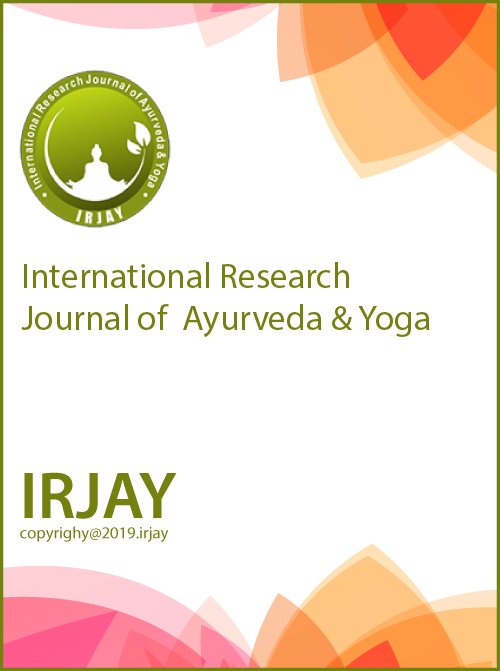A Review on Role of Music in Premature Infants Mentioned in Charaka Samhita
DOI:
https://doi.org/10.48165/IRJAY.2023.6906Keywords:
Music therapy, NICU, Pre-term infants, Protective measure, SamavedaAbstract
Music therapy has been in use since ages in healing various ailments across the globe. As an evidence-based, allied health-care profession, it is flourishing in western world where various programs, bachelor degrees, and foundations are being laid down. In India, music has got its roots from Samaveda where it is being mentioned to be used for various purposes. In Ayurveda, it is described as a Vajikaraka (aphrodisiacs), as a pitta Dosha pacifier, as a protective measure for new born, for Nidranasha (insomnia) treatment, etc. More detailed or evidence-based study should be done on how does the music effect the individual in these conditions. In this article, a possible view on role of music in premature infants is explained. We can use the results extracted to promote health in this form. As evidence-based study has more importance in today’s world so there is a need to validate old facts with recent researches.
Downloads
References
Choudhary and Roman: Role of Music in Premature Infants 2023; 6(9):30-33 33 p. 406.
Flo BK, Matziorinis AM, Skouras S, Sudmann TT, Gold C, Koelsch S. Study protocol for the Alzheimer and music therapy study: An RCT to compare the efficacy of music therapy and physical activity on brain plasticity, depressive symptoms, and cognitive decline, in a population with and at risk for Alzheimer’s disease. PLoS One 2022;17:e0270682.
Janzen TB, Thaut MH. Rethinking the role of music in the neurodevelopment of autism spectrum disorder. Music Sci 2018;1:1-8. 3. Bradt J, Dileo C, Potvin N. Music for stress and anxiety reduction in coronary heart disease patients. Cochrane Database Syst Rev 2013;2013:CD006577.
Magee WL, Clark I, Tamplin J, Bradt J. Music interventions for acquired brain injury. Cochrane Database Syst Rev 2017;1:CD006787. 5. Keough L. Assessment-based small-group music therapy programming for individuals with dementia and Alzheimer’s disease: A multi-year clinical project. Music Ther Perspect 2017;35:181-9. 6. Van Der Meulen I, Van De Sandt-Koenderman MW, Heijenbrok MH, Visch-Brink E, Ribbers GM. Melodic intonation therapy in chronic aphasia: Evidence from a pilot randomized controlled trial. Front Hum Neurosci 2016;10:533.
Bradt J, Dileo C, Myers-Coffman K, Biondo J. Music interventions for improving psychological and physical outcomes in people with cancer. Cochrane Database Syst Rev 2021;2021:CD006911.
Albergato-Muterspaw F. The Role of Music in Healing and Grief Processes of Bereaved Adult Learners. Thesis. The Pennsylvania State University; 2009.
Keen AW. Using music as a therapy tool to motivate troubled adolescents. Soc Work Health Care 2005;39:361-73.
La Gasse AB, Thaut MH. Music and Rehabilition: Neurological Approaches. United Kingdom: Oxford Academic; 2012. p. 153-63. 11. Kunjalal K. SushrutaSamhita, Chikitsasthan 26/7. Varanasi: Chowkhambha Sanskrit Series Office; 2007. p. 598.
Sharma RK, Bhagwan D. Agnivesa’s Charaka Samhita Vimansthan. Varanasi: Chowkhambha Sanskrit Series Office; 2010.
Sharma RK, Bhagwan D. Agnivesa’s Charaka Samhita, Chikitsa Sthan. 8/186. Varanasi: Chowkhambha Sanskrit Series Office; 2010.
Bhishagratna K. Sushruta Samhita, Chikitsa 34/12. Varanasi: Chowkhambha Sanskrit Series Office; 2007.
Sharma RK, Bhagwan D. Agnivesa’s Charaka Samhita, Sharir Sthan 8/47. Varanasi: Chowkhambha Sanskrit Series Office; 2010. 16. Shastri AD. Sushruta Samhita of Maharishi Sushruta, Sharir Sthana 10/7. Varanasi: Chaukhambha Sanskrit Sansthan; 2015.
Murthy KR. Srikantha, Astanga Samgraha of Vagbhata, Uttara Sthana, ¼. Varanasi: Chaukhambha Orientalia; 2012.
Meadows A. Developments in Music Therapy Practices: Case Study Perspectives. New Hampshire: Barcelona Publishers; 2011. 19. Schlez A, Litmanovitz I, Bauer S, Dolfin T, Regev R, Arnon S. Combining kangaroo care and live harp music therapy in the neonatal intensive care unit setting. Isr Med Assoc J 2011;13:354-8. 20. Loewy J. Music and Medicine: Music Therapy for Infants & Quot. The Music Instinct Science and Song; Produced by WNET.ORG and Mannes Productions Inc.; 2009. Available from: https://www. pbs.org/wnet/musicinstinct/video/interviews/music-and-medicine music-therapy-for-infants/76 [Last accessed on 2023 Apr 14]. 21. Standley JM. The effect of music and multimodal stimulation on responses of premature infants in neonatal intensive care. Pediatr Nurs 1998;24:532-8.
Standley JM, Moore RS. Therapeutic effects of music and mother’s voice on premature infants. Pediatr Nurs 1995;21:509-12, 574. 23. Krueger C, Horesh E, Crossland BA. Safe sound exposure in the fetus
and preterm infant. J Obstet Gynecol Neonatal Nurs 2012;41:166-70. 24. Yurkovich J, Burns DS, Harrison T. The Effect of music therapy entrainment on physiologic measures of infants in the cardiac intensive care unit: Single case withdrawal pilot study. J Music Ther 2018;55:62-82.

